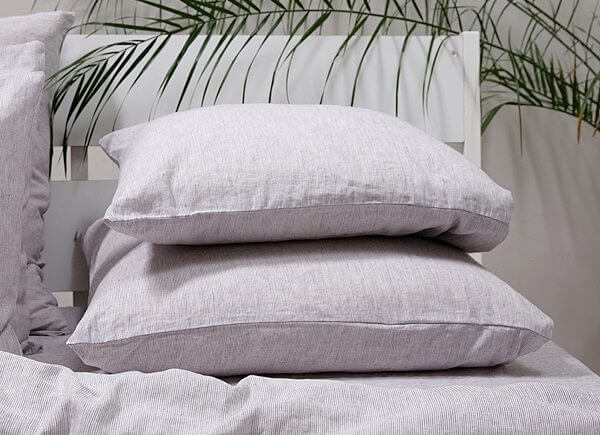
Is Linen A Sustainable Fabric?
Is linen a sustainable fabric?
As we're all becoming more aware of the effects of climate change, many of us are trying to live in a more sustainable way and reduce our carbon footprint. There are simple things we can all do to reduce our impact on the environment, from switching to renewable energy supplies, using eco-friendly household cleaning products, recycling, reducing our car use, eating local food produce and buying textiles made from a sustainable material like linen.

Here's why using linen is one of the easy ways you can make your home more sustainable. By using your consumer power to choose naturally-sourced, eco-friendly fabrics for your clothing, bedding, towels and kitchen linen you can make a positive difference:
How sustainable linen is made from flax
 Linen is made from the flax plant, a blue-purple flowered plant that grows especially well in Northern Europe. It is one of the oldest, best-loved textiles in the world and has been used for centuries. The flax plant requires less water to cultivate than other textile crops like cotton, and can be grown without pesticides.
Linen is made from the flax plant, a blue-purple flowered plant that grows especially well in Northern Europe. It is one of the oldest, best-loved textiles in the world and has been used for centuries. The flax plant requires less water to cultivate than other textile crops like cotton, and can be grown without pesticides.
Bi-products from the flax plant can be used in a wide range of areas, like making linseed oil and paints from the seeds, or rope from the excess fibres. So many of the things we see around us everyday are actually made from flax – from bank notes to cigarette papers. If you think flax is just about linen tablecloths, think again!
The production process hasn't changed much over centuries, like the retting of flax fibers (laying the cut plant on the ground and letting moisture separate the useful fibers) and weaving them into linen threads on traditional hand looms that are still used today. Whilst modern technology has developed new production techniques, these eco-friendly ancient methods are still used to create linen around the world today. Compared to synthetic, man-made materials, the natural linen fabric production process uses fewer chemicals, boosting its sustainability credentials.
Durability has environmental benefits

To ensure that you're buying sustainably grown and produced linen opt for certified European linen. This certifies that at all stages in the process, from flax plant to finished product, the manufactures comply with strict ethical and environmental regulations. This will also guarantee that the fabric is good quality and will last for a long time. Linen made in other parts of the world, like China, for example, may not have to meet such stringent environmental standards.
Linen is a durable fabric, which means big environmental benefits like less waste going to land fill, and the need for fewer products as the ones we have keep on going for years.
Fast fashion is damaging to the planet, encouraging the frequent purchasing and discarding of clothes or home textiles. Linen can transcend this, thanks to its timeless beauty and durability, meaning it's always a stylish addition to your wardrobe and home. Unlike some synthetic fabrics that wear thin and are easily damaged, linen actually gets better with every wash and use. And when it does come to the end of its useful life, linen is naturally biodegradable and won't clog up land fill tips or the oceans like synthetic fibres and materials.
Organic linen versus organic cotton
Natural fabric like cotton, linen and wool are usually more sustainable than man-made fabric. Organic crops and plants are grown without pesticides and chemical compounds, minimising environmental damage. Many fashion brands are switching to organic cotton, which is an improvement, but organic linen is even better. Cotton requires more resources throughout the production process than organic linen, making it less eco-friendly.
Second only to hemp, the flax plant is the world's most productive crop per hectare, outperforming cotton crops and making better use of the land. Organic linen is grown using a system of crop rotation, which ensures the soil is protected and prevents soil degeneration, as well as looking after important eco-systems.

![]() Why linen is good for the environment: In brief
Why linen is good for the environment: In brief
- Requires fewer resources and less water to grow and produce
- Can be grown without pesticides and chemicals
- Durability means each piece lasts longer and reduces waste
- Natural biodegradable material which reduces waste
Buying linen fabric online
So, we've convinced you of linen's eco-friendly benefits, and you already know how it brings an effortless beauty and style to any interior. What next? If you're buying your linen clothes, homewares or textiles online there are some important things to consider before making the purchase:
- Is it certified European linen? If not, it may be inferior quality or not have been produced with such rigorous sustainability regulations. Temperate areas of Europe are ideal growing regions for linen, and local growers often have many years' experience working with flax.
- Buy from reputable brands. When buying linen fabric, try not to be swayed by a cheap price. This could be a poorer quality fabric, or even a cotton linen mix rather than a pure linen material. Some brands produce items that are called 'linen' when they actually only contain a small percentage compared to true linen.
- Check whether the fabric has been pre-washed. Linen tends to shrink when first washed, so many manufacturers will pre-wash their garments and fabric to minimise any further shrinkage.

- If you're not sure, order a linen swatch. If you're trying to find the perfect color or texture, order a sample swatch of linen first. That way you can see how it feels, and place it in your home next to the various other textiles, items and wall colors it will need to work with. Good quality linen fabric is tightly woven, has natural slubbing and feels strong but not stretchy when pulled gently.
- Think long-term. Because linen is fantastically long-lasting it's worth buying fabric that you'll still love in years to come. Linen never goes out of fashion, but you might want to think about the colors that will endure and that could survive any major redecoration.
- Choose your weave. Linen isn't only woven in one way. Each different production process creates a range of weaves such as:
- waffle weave (great for towels)
- damask (a delicate, ornate finish)
- plain-woven (usually found in kitchen linens like tea towels),
- loose-woven (highly absorbent)
- sheeting linen (tightly woven, with a high thread count and often used as a bedding fabric)
- suiting linen (medium weight, good for summer suits)

Remember: linen gets better with age!
Linen is one of the most sustainable fabrics you can choose for your home and wardrobe. And because flax is one of the oldest sources of textiles it pre-dates synthetic additions, pesticides and chemicals. To be certain your linen is made according to the highest modern eco-friendly standards from flax that hasn't been treated with pesticides, opt for organic linen and check for a certification. And always buy from ethical brands that put the environment at the heart of their production process.
That way you can do your bit to live a more sustainable life, and find beautiful, great quality linen homewares and clothing that get better with every use and every wash.
